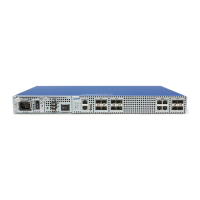User Manual UMN:CLI
V5808
387
To disable the flooding of multicast and unicast packets to an interface, use the following
command.
port flood-block PORTS bcast
Blocks Broadcast forwarding to the port.
port flood-block PORTS dlf
Blocks DLF forwarding to the port.
To flood the multicast and unicast packets to an interface, use the following command.
no port flood-block PORTS
bcast
Floods Broadcast forwarding to the port.
no port flood-block PORTS dlf
Floods DLF forwarding to the port.
To display the configured flood blocking, use the following command.
Shows the configured flood blocking.
8.9.2 CPU Flood Guard
CPU flood guard controls the number of broadcast and multicast packets per second,
which is coming to CPU to prevent CPU overload. If the number of those packets
exceeds the threshold, the system generates an SNMP trap.
To enable/disable the CPU flood guard, use the following command.
cpu-flood-guard {enable |
disable}
Enables/disables the CPU flood guard.
To specify the number of broadcast and multicast packets per second, which is coming to
CPU, use the following command.
cpu-flood-guard PORTS
<1-6000>
Specifies the number of broadcast and multicast
packets toward CPU per second.
PORTS: port number
1-6000: the number of packets per second
no cpu-flood-guard [PORTS]
Deletes a specified number of packets.
You can also enable the blocking option. When the blocking option for CPU flood guard is
running, if the number of incoming broadcast and multicast packets per second exceeds
a configured value, the port will discard those packets during a specified time.
To enable the blocking option, use the following command.

